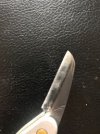- Joined
- Sep 7, 2014
- Messages
- 4
Hi everyone,
I'm drawing up a couple of ideas for a small, fixed blade carving knife an I was wondering a couple of things regarding the design of the blade:
Do you think I should go for a "straight" edge, with a pronounced drop point (sort of like a utility knife, to give you the idea) or a curved belly going up to about half the height of the blade? I see people doing both out there, I was thinking maybe just 3-4 cm long btw.
Other question: it would be stupid to grind the bevel on only one side of the blade right? I'm right handed, grinding only on the right side, kind of like a kiridashi blade, made sense. I'll probably stick with the good old two sided blade anyway.
Last thing, I'm thinking about a scandi grind but a chisel grind makes sense as well.
If some of you has experience with carving I'd appreciate his opinions.
Thx
I'm drawing up a couple of ideas for a small, fixed blade carving knife an I was wondering a couple of things regarding the design of the blade:
Do you think I should go for a "straight" edge, with a pronounced drop point (sort of like a utility knife, to give you the idea) or a curved belly going up to about half the height of the blade? I see people doing both out there, I was thinking maybe just 3-4 cm long btw.
Other question: it would be stupid to grind the bevel on only one side of the blade right? I'm right handed, grinding only on the right side, kind of like a kiridashi blade, made sense. I'll probably stick with the good old two sided blade anyway.
Last thing, I'm thinking about a scandi grind but a chisel grind makes sense as well.
If some of you has experience with carving I'd appreciate his opinions.
Thx

